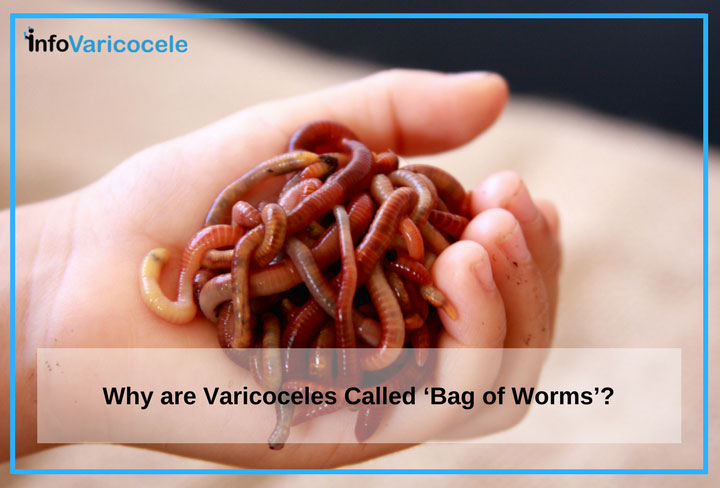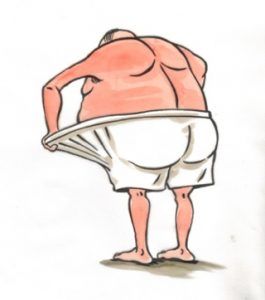
Have you recently been diagnosed with a varicocele? Varicoceles are a collection of dilated veins that are found in the scrotum. Many men who are affected by a varicocele describe their condition as looking like a bag of worms. Varicoceles occur in about 15% of all men and can be a cause of abnormal sperm and related to infertility. [i-ii] There are surgical treatments that are effective in treating varicoceles, but if you’re looking for a way to treat varicoceles without surgery, you should ask your doctor about an effective treatment option known as varicocele embolization. Varicocele embolization is a minimally invasive procedure that involves the placement of small coils in the affected veins in order to redirect blood flow to other veins and stop the blood flow in the dilated ones.
Why the term ‘Bag of Worms’?
 The term ‘bag of worms’ describes what you or a physician may feel when examining the scrotum of a man with varicoceles. The collection of dilated veins can feel like a twisted bunch of worms. So why does this develop?
The term ‘bag of worms’ describes what you or a physician may feel when examining the scrotum of a man with varicoceles. The collection of dilated veins can feel like a twisted bunch of worms. So why does this develop?
How Does a Varicocele Develop?
A varicocele is essentially a varicose vein, most often on the left side of the scrotum. To understand why varicose veins, or dilated veins, develop, it’s helpful to understand some basic anatomy.
There are two types of blood vessels in the human body. They are:
- Arteries that carry the blood away from the heart to the body.
- Veins that return the blood from the body back to the heart.
Arteries are very muscular, but veins are less so and rely on valves to make sure blood from flowing back towards the heart. All of the veins ultimately empty into the vena cava, which is the big vein within our torso that brings the blood back to the heart. In cases where the muscles of the veins are weakened or the valves are not properly preventing the back, or reverse flow of blood, pressure builds up. Because the walls of the veins are elastic, they accommodate the backflow by stretching, or dilating. These dilated veins, when they occur in the scrotum, are known as varicoceles.
Anatomy: Testicular Veins
You need to know a little more anatomy to understand why a varicocele forms and why it most commonly forms on the left side.[iii] The left testicle is more likely to develop a varicocele because the left testicular vein, the vein draining the left testicle, runs essentially straight up through the body and empties into the left renal vein, or the vein of the left kidney. This connection is at a 90-degree angle. The right testicular vein empties directly into the inferior vena cava at a shallow angle. Imagine how cars enter the highway. It is a lot easier to merge at a shallow angle than it is to make a 90-degree turn. A 90-degree turn onto a highway will lead to a back up of cars, in this same way, the blood in the left testicular vein can back up easily as well.[iii]
More Anatomy: The ‘Fight or Flight’ Hormones
Sitting above the left kidney, near the insertion of the left testicular vein into the left renal vein, is the left adrenal gland. There are two adrenal glands, one sits above each of the kidneys. These glands are responsible for producing many hormones in our body. This includes catecholamines, the hormones that control our ‘fight or flight’ response. If you are alone in the woods and run into a bear, your adrenal glands will release a lot of catecholamines in response to seeing the bear, and you would be geared up to run or fight. The adrenal glands release small amounts of these hormones in response to what you are doing every day. These hormones are emptied into the renal veins. The left testicular vein is very close to this high concentration of hormones from the left adrenal gland, and this is thought to lead to constriction of the vein and increased pressure because the blood is not draining from the vein. [iii]
Varicoceles are a collection of dilated veins within the scrotum that are often described as feeling like a bag of worms. If you’ve been diagnosed with a varicocele and are interested in pursuing treatment to correct the condition, you can either go the surgical route or, for a minimally invasive option, consider varicocele embolizationvaricocele embolization.
Sources:
[i] Choi, W., and Kim, S., Current Issues in Varicocele Management: A Review. World J Mens Health, 2013. 31(1): p. 12-20.
[ii] http://americanpregnancy.org/infertility/male-infertility
[iii] ikitis, N., et. al., Mysteries, Facts, and Fiction in Varicocele Pathophysiology and Treatment. European Urology Supplements, 2014. 13: p. 89-99.


